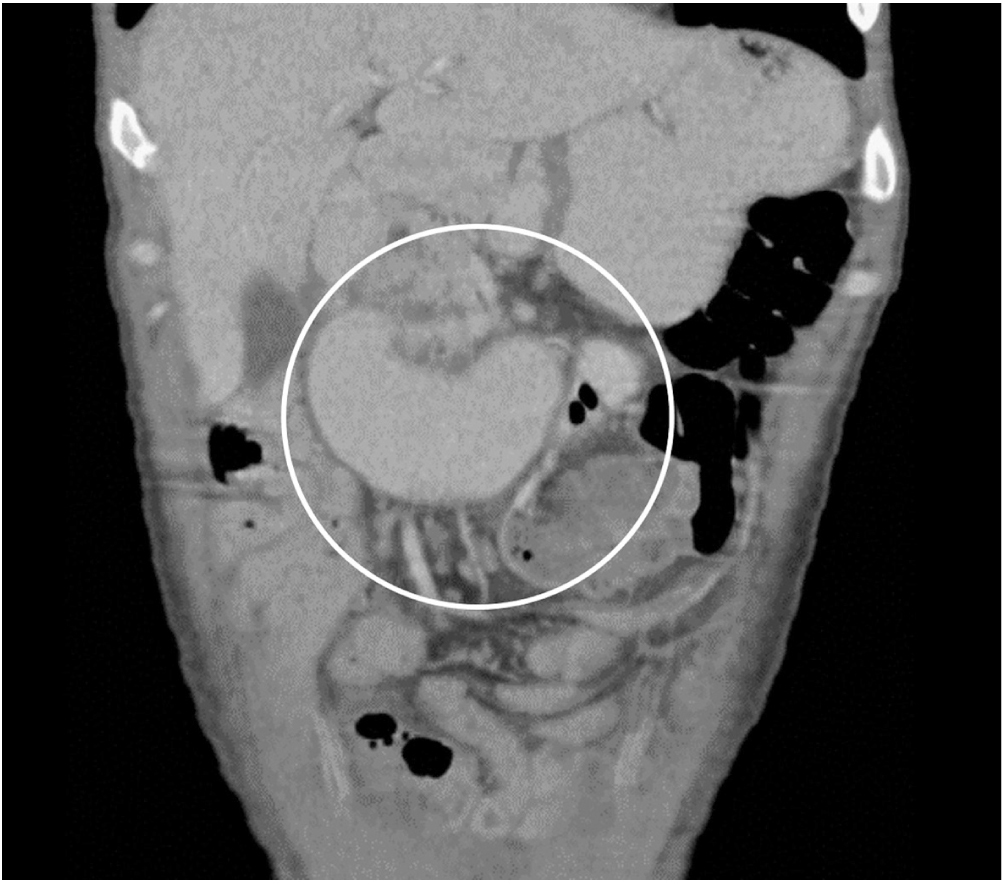Pyloric Exclusion with Ovesco (Over-the-scope-clip) Device for Jejunal Fistula in Duodenal Obstruction of Malignant Etiology
DOI:
https://doi.org/10.22516/25007440.805Keywords:
gastrointestinal fistula, endoscopic closure, ovesco clipsAbstract
A 25-year-old man diagnosed with a non-seminomatous germ cell tumor was admitted to the emergency department for diffuse abdominal pain associated with bloating and multiple emetic episodes. Due to the clinical suspicion of intestinal obstruction, a contrasted abdominal tomography was performed, showing an obstruction in the third duodenal portion resulting from extrinsic compression caused by multiple retroperitoneal conglomerates.
Surgical time was scheduled for a gastric bypass surgery where gastrojejunostomy was performed using conventional technique. On the fifth postoperative day, he presented clinical deterioration due to febrile episodes, abdominal pain, and tachycardia. A new abdominal tomography was performed, reporting an intra-abdominal collection of pus on the left flank of 12 x 12 x 5 cm secondary to the jejunal fistula process. Hence, percutaneous drainage management of the collection was performed by interventional radiology and drainage catheter placement. In addition, an EGD was performed to conduct a pyloric exclusion technique with an Ovesco (over-the-scope-clip) device for managing the jejunal fistula, which was technically successful.
A gastrointestinal tract X-ray was performed as a follow-up during the postoperative stage, showing no pyloric continuity with adequate patency of the gastrojejunostomy. In addition, a contrasted abdominal CT scan showed a decrease in the intra-abdominal collection without extravasation of the contrast medium.
This case outcome suggests the Ovesco device may be helpful in proximal GI fistulas cases, especially in patients with multiple comorbidities or poor general conditions who may benefit from minimally invasive procedures decreasing the risk of fatal outcomes.
Downloads
References
Mönkemüller K, Martínez-Alcalá A, Schmidt AR, Kratt T. The Use of the Over the Scope Clips Beyond Its Standard Use: A Pictorial Description. Gastrointest Endosc Clin N Am. 2020;30(1):41-74. https://doi.org/10.1016/j.giec.2019.09.003
Mosquera-Klinger G, Torres-Rincón R, Jaime-Carvajal J. Endoscopic closure of gastrointestinal perforations and fistulas using the Ovesco Over-The-Scope Clip system at a tertiary care hospital center. Rev Gastroenterol Mex. 2019;84(2):263-6. https://doi.org/10.1016/j.rgmx.2018.10.004
Ribeiro-Parenti L, De Courville G, Daikha A, Arapis K, Chosidow D, Marmuse JP. Classification, surgical management and outcomes of patients with gastrogastric fistula after Roux-En-Y gastric bypass. Surg Obes Relat Dis. 2017;13(2):243-8. http://doi.org/10.1016/j.soard.2016.09.027
Mangiavillano B, Caruso A, Manta R, Di Mitri R, Arezzo A, Pagano N, et al. Over-the-scope clips in the treatment of gastrointestinal tract iatrogenic perforation: A multicenter retrospective study and a classification of gastrointestinal tract perforations. World J Gastrointest Surg. 2016;8(4):315. https://doi.org/10.4240/wjgs.v8.i4.315
Lee HL, Cho JY, Cho JH, Park JJ, Kim CG, Kim SH, et al. Efficacy of the over-the-scope clip system for treatment of gastrointestinal fistulas, leaks, and perforations: A Korean multi-center study. Clin Endosc. 2018;51(1):61-5. https://doi.org/10.5946/ce.2017.027
Schroeppel TJ, Saleem K, Sharpe JP, Magnotti LJ, Jordan AW, Fischer PE, et al. Penetrating duodenal trauma: A 19-year experience. J Trauma Acute Care Surg. 2016;80(3):461-5. https://doi.org/10.1097/TA.0000000000000934
Kobara H, Mori H, Nishiyama N, Fujihara S, Okano K, Suzuki Y, et al. Over-the-scope clip system: A review of 1517 cases over 9 years. J Gastroenterol Hepatol. 2019;34(1):22-30. https://doi.org/10.1111/jgh.14402

Downloads
Published
How to Cite
Issue
Section
License
Copyright (c) 2022 Revista colombiana de Gastroenterología

This work is licensed under a Creative Commons Attribution-NonCommercial-NoDerivatives 4.0 International License.
Aquellos autores/as que tengan publicaciones con esta revista, aceptan los términos siguientes:
Los autores/as ceden sus derechos de autor y garantizarán a la revista el derecho de primera publicación de su obra, el cuál estará simultáneamente sujeto a la Licencia de reconocimiento de Creative Commons que permite a terceros compartir la obra siempre que se indique su autor y su primera publicación en esta revista.
Los contenidos están protegidos bajo una licencia de Creative Commons Reconocimiento-NoComercial-SinObraDerivada 4.0 Internacional.



















